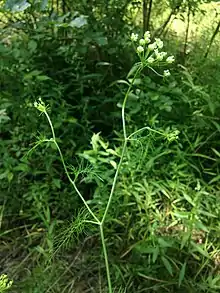Ptilimnium costatum
Ptilimnium costatum, commonly called big bishopweed,[1] is a species of flowering plant in the carrot family (Apiaceae). It is native eastern to North America, where it is found in the southeastern United States. It has a scattered and disjunct distribution, and is rare throughout its range.[1] Its natural habitat in wetlands, such as swamps, marshes, and wet prairies.[1][2]
| Ptilimnium costatum | |
|---|---|
 | |
| Scientific classification | |
| Kingdom: | Plantae |
| Clade: | Tracheophytes |
| Clade: | Angiosperms |
| Clade: | Eudicots |
| Clade: | Asterids |
| Order: | Apiales |
| Family: | Apiaceae |
| Genus: | Ptilimnium |
| Species: | P. costatum |
| Binomial name | |
| Ptilimnium costatum | |
Ptilimnium costatum is a robust perennial, growing to 150 cm tall. It produces umbels of small white flowers. It flowers and fruits from June to October, which is generally later in the season that other Ptilimnium in its range. In addition, it can be distinguished from other nearby Ptilimnium by its longer fruit styles (1–2 mm) and perennial habit from a corm base.[1]
Populations that were previously considered Ptilimnium costatum in the West Gulf Coastal Plain of Arkansas, Louisiana, and Texas, have been treated as Ptilimnium texense as of 2010. This reinstatement was based on combination of molecular, morphological, and ecological evidence.[3]
References
- Weakley, Alan (2015). "Flora of the Southern and Mid-Atlantic States".
- Yatskievych, George (2006). Flora of Missouri, Volume 2. Missouri Botanical Garden Press. p. 99.
- Feist, Mary (2010). "The reinstatement of Ptilimnium texense (Apiaceae) and a new key to the genus". Journal of the Botanical Research Institute of Texas. 4 (2): 641–651. JSTOR 41972087.